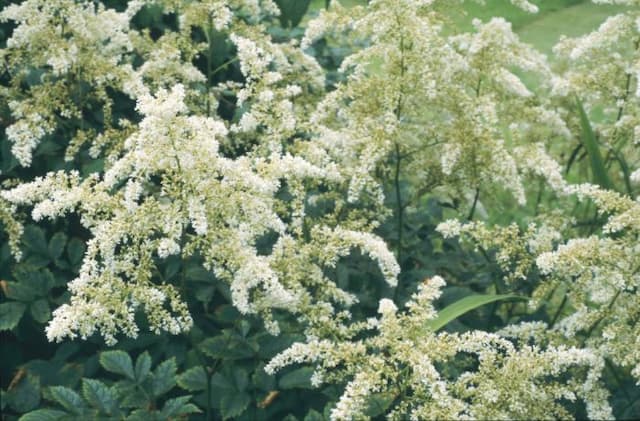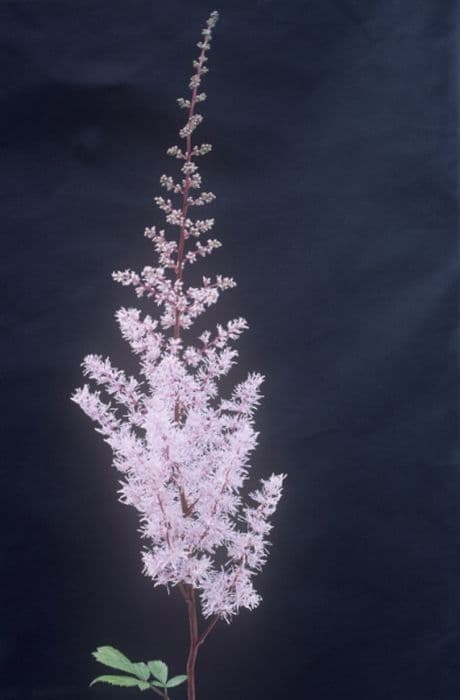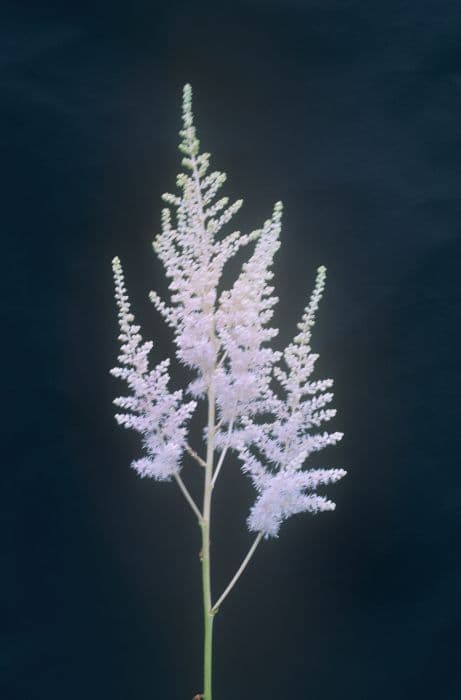False Goat's Beard Astilbe 'Gertrud Brix' (× arendsii)

ABOUT
Astilbe 'Gertrud Brix' is an ornamental perennial plant known for its captivating feathery plumes. The blooms are a stunning shade of pink, creating a soft and frothy appearance that adds texture and color to any garden space. These plumes are made up of tiny, densely packed flowers that rise above the foliage on sturdy stalks, giving the plant an airy, elegant look. The leaves of Astilbe 'Gertrud Brix' are deeply divided and fern-like, providing a lush green backdrop that contrasts beautifully with the bright blooms. The foliage often has a glossy finish, reflecting light and adding to the plant's visual interest. The plant forms a clump of these attractive leaves, making it a great choice for filling in garden beds or borders. When in bloom, the contrast between the delicate flowers and the bold foliage creates a striking display in any garden. Astilbe 'Gertrud Brix' has a bushy growth habit and presents its blooms in a showy, yet graceful manner. This makes it an ideal candidate for gardeners looking to create a sense of softness and romance in their landscapes.
About this plant
 Names
NamesFamily
Saxifragaceae
Synonyms
False Goat's Beard, False Spirea
Common names
Astilbe × arendsii 'Gertrud Brix'
 Toxicity
ToxicityTo humans
False Spirea (Astilbe × arendsii 'Gertrud Brix') is not considered toxic to humans. There are no well-documented cases or symptoms of poisoning from consuming or coming into contact with False Spirea. Ingesting any part of the plant should not have harmful consequences, but it's always advisable to avoid consuming plants that are not meant for consumption as they may cause irritation or allergic reactions in some individuals.
To pets
False Spirea (Astilbe × arendsii 'Gertrud Brix') is generally considered non-toxic to pets such as dogs and cats. There is no documented toxicity related to pets ingesting this plant, and it is unlikely to cause poisoning. However, as with any non-food plant, ingestion of large amounts could potentially lead to mild gastrointestinal discomfort, such as vomiting or diarrhea, mainly due to the ingestion of non-digestible matter rather than specific toxicity.
 Characteristics
CharacteristicsLife cycle
Perennials
Foliage type
Deciduous
Color of leaves
Green
Flower color
Pink
Height
2 feet (60 cm)
Spread
2 feet (60 cm)
Plant type
Herb
Hardiness zones
4
Native area
Asia
Benefits
 General Benefits
General Benefits- Aesthetically Pleasing - Astilbe 'Gertrud Brix' is known for its attractive, fluffy flower plumes that add a touch of elegance to any garden.
- Shade Tolerant - This plant thrives in shady conditions where other plants may struggle, making it an excellent choice for gardens with limited sunlight.
- Low Maintenance - Astilbe is a low-maintenance plant, requiring minimal care once established in a suitable location.
- Attracts Pollinators - The flowers of Astilbe 'Gertrud Brix' attract butterflies and other beneficial insects, supporting biodiversity.
- Adds Texture - The fern-like foliage and feathery blooms provide unique texture to garden compositions.
- Seasonal Interest - Offering a seasonal display with its blooms in late spring or early summer, it helps create a dynamic garden environment through the year.
- Variety of Uses - Astilbe can be used in mixed beds, borders, and as understory plantings, making it a versatile addition to the landscape.
- Drought Resistance - Once established, it can withstand periods of dryness, although it prefers consistently moist soil.
- Soil Stability - The root system of Astilbe helps in preventing soil erosion, particularly when planted on slopes or in areas with loose soil.
- Deer Resistant - This plant is typically not a favorite of deer, which can help preserve your garden's look in areas where deer are a problem.
 Medical Properties
Medical PropertiesThis plant is not used for medical purposes.
 Air-purifying Qualities
Air-purifying QualitiesThis plant is not specifically known for air purifying qualities.
 Other Uses
Other Uses- Astilbe is often used as a natural dye for fabrics. The roots and flowers can be boiled to extract color for textile dyeing.
- In craft projects, the dried flowers of Astilbe can be incorporated into homemade paper to give it a unique texture and pattern.
- Its dense foliage can provide a hiding spot for beneficial garden creatures such as frogs and toads, which help control pests.
- The flower plumes of Astilbe can be included in potpourri mixes for their texture and subtle contribution to the potpourri's overall scent.
- These plants can also be used effectively for erosion control due to their clumping habit and ease of growth in moist soil conditions.
- In aquarium setups, dried Astilbe can be used as part of the decor, providing a naturalistic look to the habitat.
- Astilbe flowers can be used as natural confetti for outdoor celebrations because they are biodegradable and less harmful to the environment than plastic confetti.
- Garden photographers sometimes use the Astilbe's vibrant and feathery blooms as a backdrop for photographing insects and other small wildlife.
- The stems of dried Astilbe flowers can be woven into wreaths and other decorative items to add a rustic charm to home decor.
- Astilbe is utilized in floral arrangements for their fluffy appearance and can be used to provide contrast in texture and form.
Interesting Facts
 Feng Shui
Feng ShuiThe Astilbe is not used in Feng Shui practice.
 Zodiac Sign Compitability
Zodiac Sign CompitabilityThe Astilbe is not used in astrology practice.
 Plant Symbolism
Plant Symbolism- Patience: Astilbe often takes time to bloom and thrives in the shade, symbolizing the virtue of patience and the understanding that all things bloom in their own time.
- Enduring Love: With its feathery plumes and long-lasting blooms, astilbe is associated with a commitment that endures through time and challenges.
- Strength in Adversity: Astilbe can thrive in challenging conditions, such as the shade where other plants may falter, representing resilient strength.
- I'll Still Be Waiting: The name resemblance to the phrase "I'll still be" can lend this flower a symbolic meaning of waiting or anticipation for a loved one.
- Dedication: As astilbe needs consistent moisture and care to flourish, it can symbolize dedication and attentiveness in relationships.
 Water
WaterFalse Spirea (Astilbe 'Gertrud Brix') thrives in consistently moist soil, so regular watering is essential, especially during dry periods. Water your False Spirea deeply about twice a week to keep the soil moist to a depth of a few inches. During periods of high heat or drought, you may need to water more frequently to maintain moisture levels. Providing about one inch of water weekly, whether from rainfall or watering, is a good guideline. Make sure not to let the soil dry out completely, as False Spirea is sensitive to drought.
 Light
LightFalse Spirea (Astilbe 'Gertrud Brix') prefers partly shaded conditions, thriving in a spot that receives morning sunlight with afternoon shade or dappled sunlight throughout the day. Avoid placing it in full sun, as this can scorch the leaves and lead to stress, especially in hotter regions. A location with filtered light under a canopy of trees or on the north or east side of a building is ideal.
 Temperature
TemperatureFalse Spirea (Astilbe 'Gertrud Brix') grows best in temperate climates with temperatures ranging from 60 to 75 degrees Fahrenheit during the growing season. These plants are hardy and can survive winter temperatures as low as -20 degrees Fahrenheit, but they require a winter rest period with cooler temperatures to thrive. Ideally, provide protection from extreme heat, as temperatures consistently above 80 degrees Fahrenheit can stress the plant.
 Pruning
PruningFalse Spirea (Astilbe 'Gertrud Brix') should be pruned to remove spent flowers and encourage a tidy growth habit. Deadheading after blooming can promote a second flush of flowers. In late winter or early spring before new growth starts, cut back any dead or damaged stems to the ground. Prune every year to maintain plant vigor and appearance.
 Cleaning
CleaningAs needed
 Soil
SoilFalse Spirea (Astilbe 'Gertrud Brix') thrives in rich, moisture-retentive soil with good drainage and prefers a pH ranging from 6.0 to 8.0. A mix containing garden soil, compost, and a bit of perlite or vermiculite is ideal to facilitate drainage and provide organic nutrients. Mulching is beneficial to maintain soil moisture.
 Repotting
RepottingFalse Spirea (Astilbe 'Gertrud Brix') typically does not require frequent repotting and can be done every 2-3 years. It's best to repot in the spring before the growing season starts when the plant becomes root-bound or the soil appears exhausted.
 Humidity & Misting
Humidity & MistingFalse Spirea (Astilbe 'Gertrud Brix') prefers high humidity levels. For best growth and flowering, aim for a humidity level between 60-80%. If the air is too dry, the foliage may suffer, so maintaining adequate humidity is important for plant health.
 Suitable locations
Suitable locationsIndoor
Place False Spirea in bright, indirect light with moist soil.
Outdoor
Plant in partial shade, moist soil, and mulch to retain moisture.
Hardiness zone
4-9 USDA
 Life cycle
Life cycleAstilbe 'Gertrud Brix', also known as False Goat's Beard, begins its life cycle as a dormant rhizome, which germinates in early spring once soil temperatures warm up. As temperatures increase, new growth emerges, developing into a clump of finely dissected, fern-like foliage. By mid to late spring, the plant produces tall, upright stems that bear plume-like flowers in shades of pink, which bloom in early summer and attract pollinators like bees and butterflies. After flowering, the plant sets seeds that can be dispersed by wind or wildlife, potentially germinating to produce new plants. Throughout the summer, the foliage remains attractive before dying back to the ground with the onset of cooler autumn temperatures. The rhizome overwinters in the soil, ready to begin the cycle anew when conditions become favorable in the following spring.
 Propogation
PropogationPropogation time
Early Spring
The Astilbe 'Gertrud Brix', commonly known as False Spirea, is most successfully propagated by division, which is typically done in the spring or autumn to allow the plants time to establish before the harsher conditions of summer or winter. To propagate by division, one should carefully dig up an established clump of False Spirea and gently separate the root mass into smaller sections, ensuring that each new section has a good amount of roots and at least one or two growing points or shoots. These new divisions should then be replanted in a prepared bed, spaced about 18 to 24 inches (approximately 45 to 60 centimeters) apart to allow for growth and air circulation. Water the new divisions thoroughly after planting and maintain consistent moisture as they establish themselves in their new locations. This method not only helps to expand your garden with more plants but also invigorates the older plants by giving them more space to grow.









